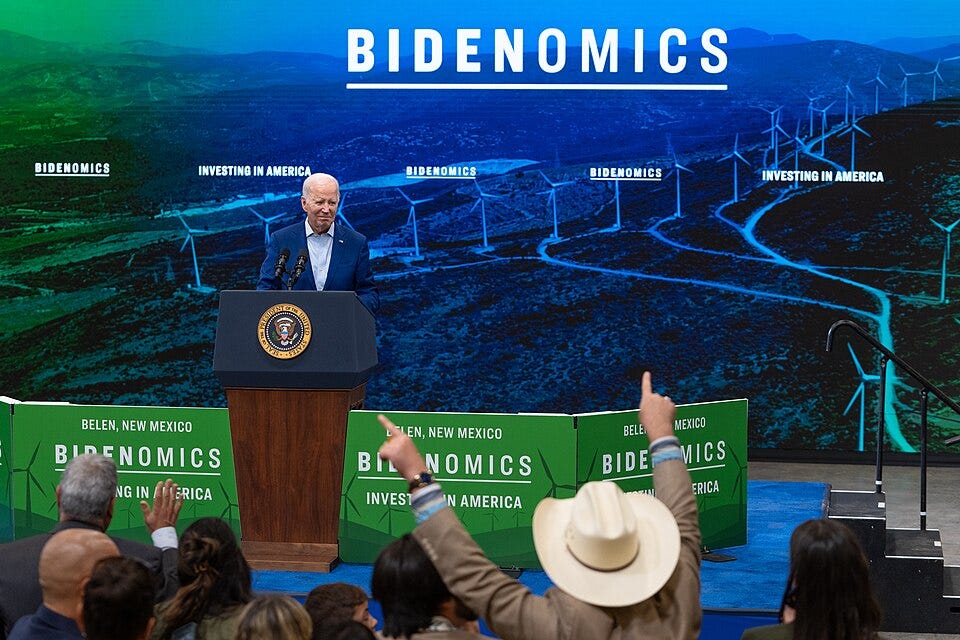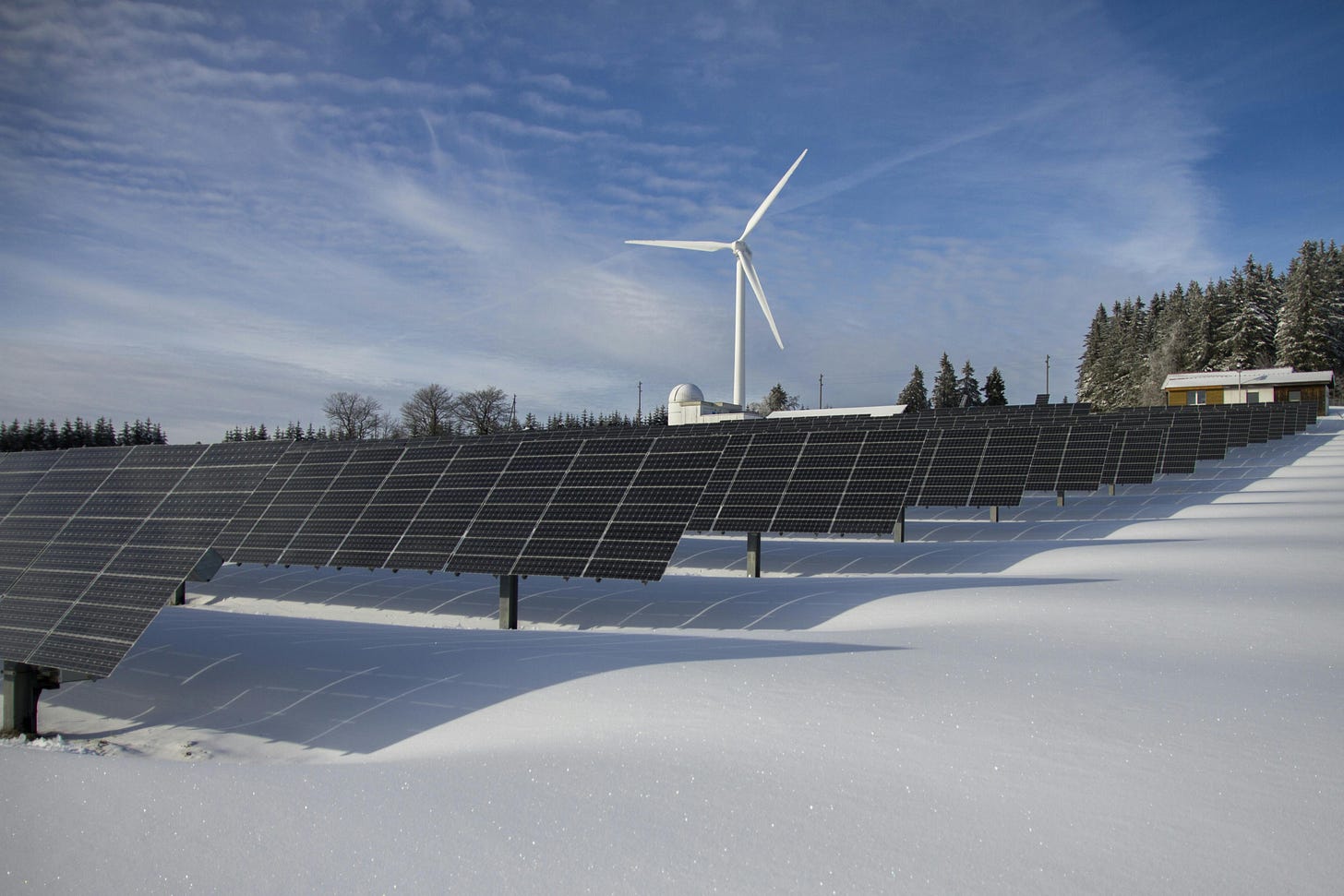How to Secure America’s Energy Future | This Week's Economy Ep. 126
A free-market blueprint for affordable, reliable American energy.
Hello Friends!
Economist Julian Simon said, “Energy is the master resource, because energy enables us to convert one material into another. As natural scientists continue to learn more about the transformation of materials from one form to another with the aid of energy, energy will be even more important.”
Energy powers our homes, fuels our industries, and drives the innovations that secure our future. However, when Washington attempts to micromanage the energy sector through regulations, subsidies, and political agendas, it distorts the market and drives up costs.
But it doesn’t have to be this way. When markets are free to work, America thrives. We’ve seen that energy abundance, competition, and innovation emerge naturally when government steps back and entrepreneurs step forward. The path to a stronger economy and a more reliable grid isn’t more government planning—it’s less!
In This Week’s Economy episode, I discuss how we got here, what’s at stake, and the four steps we must take to unleash America’s full energy potential. From ending regulations and subsidies, to rejecting ESG mandates, to fueling innovation, the blueprint is clear: trust markets, not bureaucrats, to power America’s future.
Watch or listen now on YouTube, Apple Podcast, or Spotify, and visit my website for more information.
HOW WE GOT HERE

The Background:
The Past: Under many presidents, including the most recent being President Biden, and governors, energy policy has been defined by top-down planning and heavy-handed regulation. These distortions raised prices, constrained supply, and left America with a fragile, less reliable grid.
The Present: With President Trump in office, we’re seeing a course correction—policies that promote energy abundance, restore competition, and put common sense back at the center of America’s energy strategy.
The Future: We don’t need Washington to engineer our energy future. We need the government to get out of the way. That means stripping away tax favoritism, streamlining environmental permitting, and unleashing domestic production. Energy markets—not bureaucrats—should decide where capital flows.
Energy permitting remains one of the biggest bottlenecks. Under outdated laws, such as the National Environmental Policy Act (NEPA), vital projects are often stalled for years. Pipelines, liquefied natural gas terminals, and power plants are all held hostage to red tape. If we want a resilient grid and lower prices, approvals must move at the speed of innovation—not the pace of bureaucracy.
At the core is one clear principle: government should not control economic outcomes. It should set fair rules, enforce them consistently, and then step aside. America doesn’t need another round of industrial policy or populist planning. We need a return to classical liberal principles—free markets, limited government, and individual freedom. That’s the foundation for unleashing America’s full energy potential, and people’s potential everywhere.
Keep reading for my policy recommendations to unleash America’s full energy potential!
STEP 1: Reduce Regulatory Impacts

The Principles:
Federal and state red tape is choking America’s energy future. Burdensome regulations hinder growth, impede innovation, and hinder competition from thriving. If we want a resilient energy sector, we must trust markets—not bureaucrats. A light-touch framework that unleashes competition and innovation is the only way forward.
Solutions:
Federal Policy Solutions: A free-market approach that minimizes government intervention and allows energy prices to reflect supply and demand is the most efficient and sustainable way to manage America’s energy resources.
What Can States Do? State governments should remove obstacles that hinder private investment in energy production and distribution. This ensures a competitive market that drives down costs, improves service quality, and encourages technological advancement.
Texas Leads?: Texas runs its power grid through the Electric Reliability Council of Texas (ERCOT) and has a competitive retail market for electricity—but not always for production. However, given decades of forced taxpayer funding for subsidies and preferential tax treatment, the state leads in unreliable wind and solar energy. The grid’s real backbone is reliable natural gas, which delivers power in all conditions. Texas should build on that strength by cutting red tape, rejecting federal subsidies and local abatements, and advocating for a full repeal of the green energy subsidies in Biden’s Inflation Reduction Act (IRA). Free-market energy leadership—not Washington’s mandates—will keep Texas strong.
Related: In this episode of This Week’s Economy, I discussed how energy regulations hold back growth—and why market trust unleashes innovation.
STEP 2: End Green Energy Subsidies

The Principles:
Subsidies, tax breaks, and other government handouts distort the market and undermine prosperity. When politicians funnel taxpayer dollars into “green energy” agendas, often to win votes through virtue signaling, they waste scarce resources. Even worse, they force families and businesses to rely on energy sources that frequently fail (due to lack of wind and sun), pushing people into hardship and poverty when those methods inevitably fail.
Solutions:
An Agenda that Increases Poverty: This virtue signaling props up unreliable wind and solar energy. These sources come with high costs, minimal benefits, and significant risks. Beyond hemorrhaging taxpayer dollars, this agenda leaves families more vulnerable and increases poverty. It must stop.
Learning from Failures: We have already seen the dangers of this approach. During the historic Texas freeze four years ago, when temperatures plummeted and ice and snow swept across the state, thousands were left without power. The reliance on unreliable energy contributed to blackouts that tragically resulted in about 250 estimated deaths. This may have been avoided if politicians didn’t force Americans to depend on energy sources that can’t deliver.
Let Markets Work: Subsidies, tax breaks, and other artificial market distortions create an uneven playing field. Businesses that don’t qualify for subsidies—or can’t afford to “go green”—are pushed out. Families lose choices. Prosperity suffers. Individuals and businesses should be free to choose their energy sources without government interference. Letting the market work is the only way to ensure greater prosperity, innovation, and reliability.
Related Reading: I wrote in The Washington Examiner about what the Trump administration can do to unwind Biden-era green energy subsidies and restore market trust.
STEP 3: Eliminate Public ESG Investing
The Principle:
Environmental, Social, and Governance (ESG) investing has gained traction under the banner of sustainability, social justice, and “ethical” governance. But in practice, ESG often delivers lower returns, diverts capital from productive investments, and imposes political agendas on taxpayers. Taxpayer money should be managed with one priority in mind: protecting liberty. That means limiting government—not chasing politically driven goals.
Solutions:
Undermining Economic Growth: For states that lead the nation in crude oil and natural gas production, ESG mandates pose a threat to their economic foundations. Implementing ESG standards disrupts energy investment, reduces growth, and increases costs for consumers. By diverting capital into underperforming ESG funds, states risk weakening one of their strongest competitive advantages.
Policy Pushback: Texas, Oklahoma, and Louisiana aren’t alone in rejecting ESG mandates. Across the country, states are pushing back against the misuse of taxpayer dollars. Florida and West Virginia, among others, have passed laws to prevent taxpayer money from being funneled into ESG-driven investments. The momentum is growing—states are recognizing that ESG comes with real economic costs and undermines accountability.
Leave Investments to the Private Sector: The opportunity costs of ESG are substantial. Diverting capital from high-performing, market-driven investments into politically motivated projects hinders growth, increases consumer prices, and wastes taxpayer dollars. If individuals or private firms want to invest in ESG, they are free to do so—and to take on the risks that come with it. But the government has no money of its own. It should use taxpayer dollars conservatively, transparently, and responsibly to preserve liberty and support growth—not to bankroll political agendas.
Related Reading: I wrote at The Pelican Institute why government has no business investing in ESG—and why these choices should be left to the private sector.
STEP 4: Unleash Innovation

The Principle:
The U.S. can secure its future prosperity by reducing government involvement and allowing markets to function. Market-driven solutions strengthen infrastructure, support a growing population, and sustain America’s role as a global leader. This isn’t just about keeping the lights on—it’s about preserving the entrepreneurial spirit that defines our nation and ensuring that people have the freedom to prosper.
Solutions:
Infrastructure Improvements: States must expand and modernize their infrastructure to meet surging energy demand and capitalize on the economic benefits. Growth in cryptocurrency mining, data centers, and artificial intelligence is driving much of this demand. Often viewed skeptically, these sectors are integral to the modern economy and represent the frontlines of the next economic revolution.
Rely on Market Competition: Rather than letting government dictate winners and losers, states should allow competition to determine the most efficient and reliable energy sources. A free-market approach ensures that the best ideas rise to the top, fostering innovation and delivering progress that benefits everyone.
Related Reading: In the Austin American-Statesman, I explained how Texas can lead the nation in economic and technological advancement by unleashing efficient energy.
CONCLUSION
America’s energy future depends on restoring trust in markets and removing the heavy hand of government. Regulations, subsidies, ESG mandates, and political interference have distorted the system, driving up costs and weakening reliability. Returning to limited government, free markets, and entrepreneurial freedom can help build a resilient and competitive energy sector that meets tomorrow's demands.
America remains a global leader in both economic and technological progress. Together, these reforms form a blueprint for lasting prosperity.
The choice before us is straightforward: continue down the current path of government distortion and increased dependence, or chart a new course grounded in freedom and opportunity. By trusting markets and empowering innovators, America can secure a reliable energy future, strengthen its economy, and Let People Prosper!
Related Podcast Episodes:
Over the years, I’ve had many fantastic guests on Let People Prosper to discuss energy policy. Here are some of the latest episodes you may be interested in.
Thanks for joining me for "This Week's Economy." For more insights, visit vanceginn.com and get even greater value with a paid subscription to my Substack newsletter at vanceginn.substack.com.
God bless you, and let people prosper!
Keep reading with a 7-day free trial
Subscribe to Let People Prosper to keep reading this post and get 7 days of free access to the full post archives.








